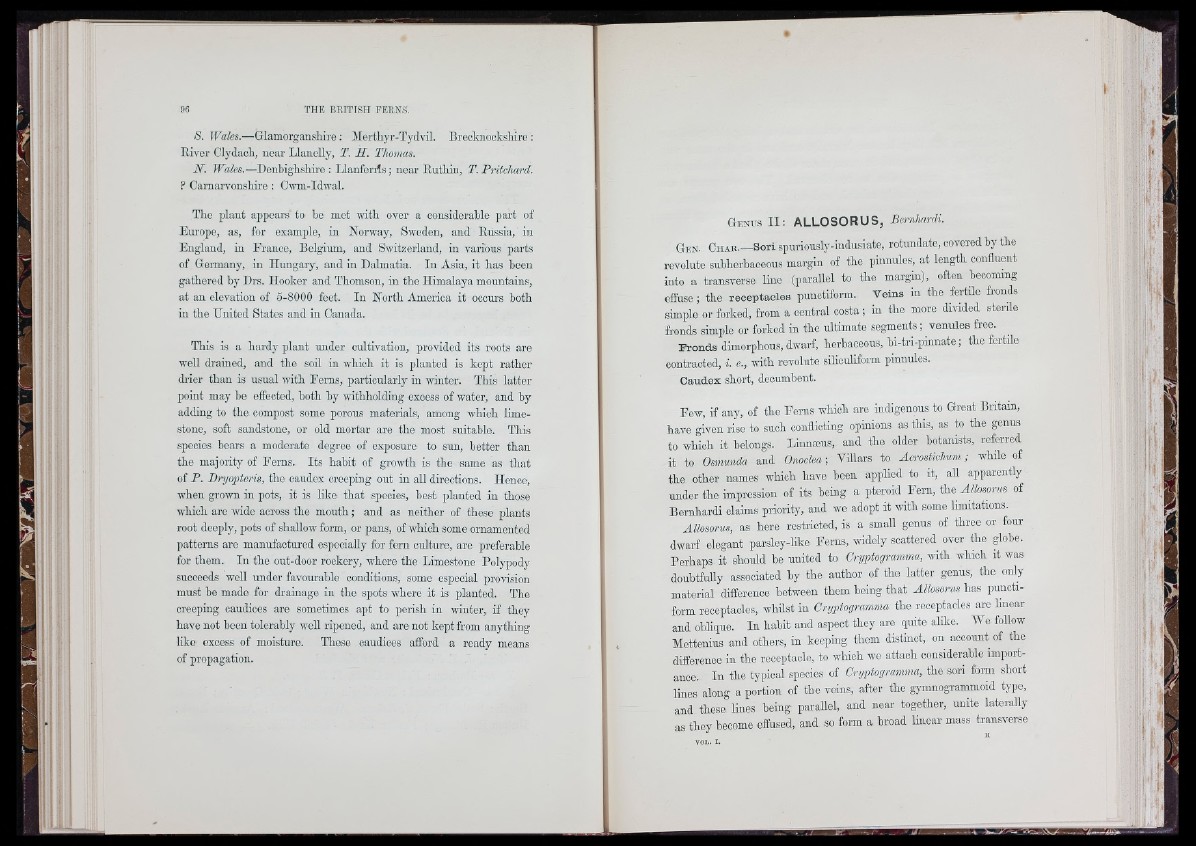
ii I
S. JFaks.—Glamorgansliirc: Mertliyr-Tydvil. Brecknockshire :
Rivor Clydach, near Llanelly, T. II . Thomas.
N . Wales.—Denbighshire : Llanferrfis; near Euthin, T. Pritchard.
? Carnarvonshire ; Owm-Idwal.
The plant appears to bo mot witb over a considerable part of
Europe, as, for example, in Norway, Sweden, and Russia, in
England, in Franco, Belgium, and Switzerland, in various parts
of Germany, in Hungary, and in Dalmatia. In Asia, it has been
gathered by Drs. Hooker and Thomson, in the Himalaya mountains,
at an elevation of 5-8000 feet. In North America it ooours both
in tho United States and in Canada.
This is a hardy plant under cultivation, provided its roots are
well drained, and the soil in Avhioh it is planted is kept rather
drier than is usual udth Ferns, particularly in Aviuter. This latter
point may be oifeoted, both by Avlthholding excess of water, and by
adding to tho compost some porous materials, among Avhioh limestone,
soft sandstone, or old mortar are the most suitable. This
species bears a moderate degree of exposure to sun, better than
the majority of Ferns. Its habit of growtb is tlie same as that
of P . Dryopteris, the caudex creeping out in all directions. Hence,
AA’hen groAvn in pots, it is like that species, best planted in those
whicli aro Avide across the mouth; and as noither of those plants
root deeply, pots of shallow form, or pans, of AAdiioh some ornamented
patterns aro manufactured especially for fern culture, are preferable
for them. In the out-door rockery, whore the Limestone Polypody
succeeds well under favourable conditions, some especial provision
must be made for drainage in the spots whoro it is planted. The
creeping caudicos aro sometimes apt to perish in winter, if they
have not been tolerably aa’c I I ripened, and are not kept from anything
like excess of moisture. These caudicos afford a ready means
of propagation.
G e n u s I I : A L LO SO R U S , Bernhardi.
Gen. Char.—Sori spuriously-indusiate, rotnndate, covered by the
revoluto snbborbaceous margin of tbe pinnules, at length confluent
into a transverse lino (parallel to the margte), often becoming
effuse ; tho receptacles punotiform. Veins in tho fertile fronds
simple or forked, from a central costa ; in tho more divided stenle
fronds simple or forked in tho ultimate segments ; venules free.
Fronds dimorphous, dwarf, herbaceous, hi-tri-pinnate ; the fertile
contraotod, i. e., Avith revolute siliculiform pinnules.
Caudex short, decumbent.
Few, if any, of the Ferns which aro indigenous to Great Britain,
have given rise to such conflicting opinions as this, as to the genus
to which it belongs. Linnæus, and the older botanists, referred
it to Osmunda and Onoclea ; Vülars to Acrostichim ; Avhile of
the other names which have been applied to it, all apparently
u n d e r the impression of its being a pteroid Fern, the AUosorus of
Bernhardi claims priority, and Ave adopt it Avith some limitations.
Allosorus, as here restricted, is a small genus of three or four
dwarf elegant parsley-like Ferns, Avidely scattered over the globe.
Perhaps it should be united to Cryptogramma, with Avhioh it was
doubtfully associated by tho author of the latter genus, the only
material difference between them boing th a t Allosorus has punotiform
receptacles, whilst in Cryptogramma the receptacles aro linear
and oblique. In hahit and aspect they are quite alike. We follow
Mettenius and others, in keeping them distinct, on account of the
difference in the roccptaolo, to which wo attach considerable importance.
In the typical species of Cryptogramma, tho sori form short
lines along a portion of the veins, after the gymnogrammoid type,
and these hues being parallel, and near together, unite laterally
as they become effused, and so form a broad linear mass transverse
H i
; IE